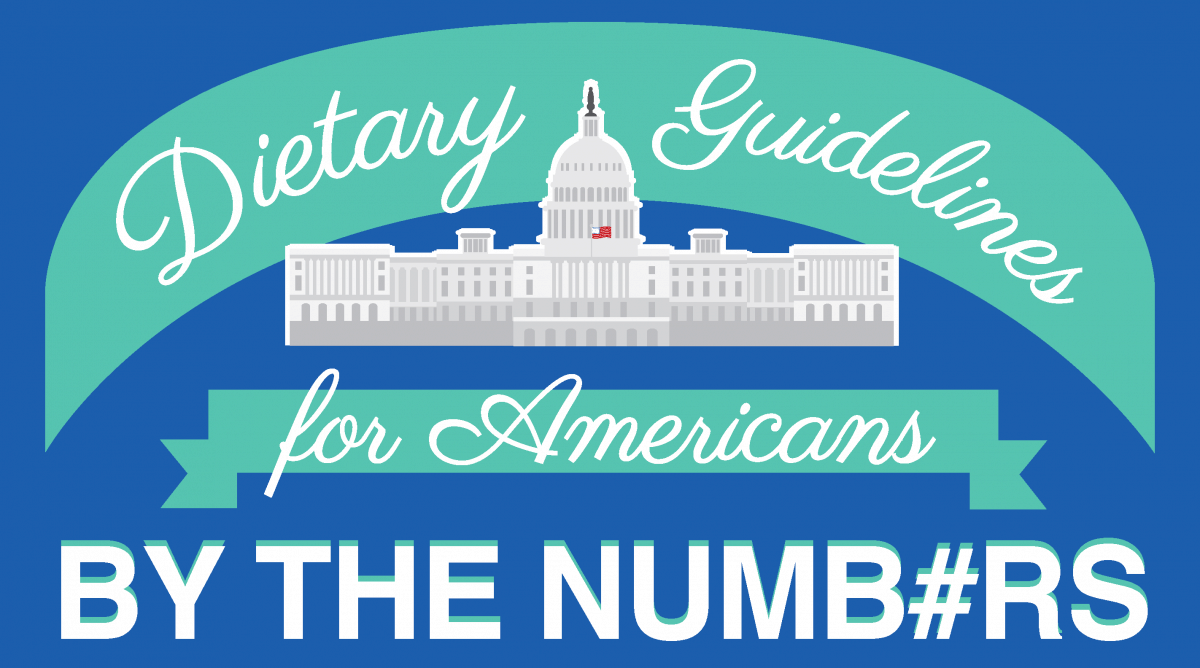Let me take you back to 1980. Pac-Man was king, the Post-It was brand new, and Blondie topped the charts. It was also the debut of the Dietary Guidelines for Americans (DGA).
Sometimes the more things change, the more they stay the same. The nutrition ‘biggies’ never change—eat more fruits and vegetables, keep your splurges sensible, and embrace balance, variety, and moderation. Every five years, a new set of guidelines sheds more light on nutrition science details and updates what we know about eating right.
In the case of the most recent DGA, a few things have changed. First off, the name. This set of DGA is officially the 2015-2020 edition, making this eighth edition the first to reflect the 5-year range it will cover as opposed to the single year in which they were finalized.
Enough about names. Here are 7 important things you need to know about the 2015-2020 DGA:
- Sugars: Old Topic, New Recommendation
- Low-Calorie Sweeteners: New Topic, Consistent Message
- Dietary Fat: Old Topic, Similar Advice
- Cholesterol: Old Topic, New Recommendation (or lack thereof!)
- Lean, Red, and Processed Meat: Old Topic, Similar Advice
- Sodium: Old Topic, Modified Recommendation
- Caffeine (Coffee): New Topic
Sugars: Old Topic, New Recommendation
One of the hottest topics of debate (not just in #DietaryGuidelines), is sugars. It seems sugars, added sugars and sugar-sweetened beverages are being scrutinized the world over, both literally and figuratively—as we’ve written about before.
The topic of sugars in the DGA is not new, however. In 2010, the DGA recommended Americans to limit their intake of Solid Fats and Added Sugars (affectionately named SoFAS at the time by the 2010 Dietary Guidelines Advisory Committee (DGAC), but now “empty calories” per the 2015 DGAC) to “no more than about 5 to 15 percent of calories.” At the time, Americans consumed about 35% of their calories (or about 800 per day) from SoFAS. Today the number of “empty calories” we eat per day has declined and is thought to be 25-30% of our total calories. It’s recommended that we cut it down to 8-19%.
The 2015-2020 DGA recommendation is to limit intake of added sugars to less than 10% of total calories per day. Currently, we get 13-17% of our calories from added sugars.
The 2015-2020 DGA notes that this recommendation “is a target based on food pattern modeling and national data on intakes of calories from added sugars that demonstrate the public health need to limit calories from added sugars to meet food group and nutrient needs within calorie limits. The limit on calories from added sugars is not a Tolerable Upper Intake Level (UL) set by the Institute of Medicine (IOM).” In other words, the recommendation to limit added sugars to less than 10% of total calories is not based on research demonstrating cause and negative health effects. Rather, this level of intake is thought to give consumers sufficient room in their diet to include key nutrients while keeping overall calorie intake at appropriate levels.
While the evidence behind the 10% recommendation is hotly debated, there is no debating that some people would benefit from reducing their total calories (sugars calories included) in the effort to achieve and/or maintain a healthy weight. All calories contribute to body weight, not just those from sugars.
Low-Calorie Sweeteners: New Topic, Consistent Message

The 2010 DGA did not review aspartame, but did make one reference to low-calorie sweeteners. The 2010 DGA explained that, “Replacing added sugars with non-caloric sweeteners may reduce calorie intake in the short-term, yet questions remain about their effectiveness as a weight management strategy.” Significant research since 2010 has demonstrated the effectiveness of low-calorie sweeteners in weight management.
The 2015 DGAC Report took a closer look at low-calorie sweeteners, particularly aspartame, mentioning it 115 times. By 2015, the number of “empty calories” we ate per day had declined and was thought to be 25-30% of our total calories. It’s recommended that we cut it down to 8-19%.
The European Food Safety Authority (EFSA) once again confirmed the strong evidence available to support aspartame’s safety in foods and beverages, and the 2015 DGAC generally concurred with EFSA. In addition to reaffirming safety on numerous occasions by regulatory, health, and scientific authorities around the world, low-calorie sweeteners such as aspartame, when consumed in the context of a healthful diet and regular physical activity, can be one tool used for weight management.
The 2015-2020 DGA agrees with leading global authorities (e.g., EFSA and FDA) that low-calorie sweeteners (e.g., acesulfame potassium (Ace-K), aspartame, saccharin and sucralose) are safe to consume. By stating, “It should be noted that replacing added sugars with high-intensity sweeteners may reduce calorie intake in the short-term, yet questions remain about their effectiveness as a long-term weight management strategy,” the 2015-2020 DGA advice on low-calorie sweeteners doesn’t differ much from that given in 2010. What this statement doesn’t make clear is that effective weight management strategies are typically personal, and may need to account for many variables beyond simply substituting low-calorie sweeteners for added sugars.
Dietary Fat: Old Topic, Similar Advice
Ok, it’s time to chew the fat. If you followed the 2015 DGAC deliberations as diligently as I did (#DGAC2015 anyone?), then you know dietary fats were an important point of discussion—so much so that they dedicated a Working Group to one fatty acid in particular, saturated fat. We’ve written about the big, fat saturated fat debate before and many news stories have claimed major changes afoot with fat, yet the guidance has stayed largely consistent.
The 2015-2020 DGA recommendation is to limit saturated fat intake to less than 10% of total calories. This advice mirrors that given in 2010. The 2015-2020 DGA rationale for continuing this advice on saturated fats has to do with reducing risk for cardiovascular disease.
The 2015 DGAC hinted at a possible removal of a long-standing limit on total dietary fat intake. The 2015-2020 DGA uses the ADMR established by the National Academies of Sciences, Engineering and Medicine (formerly the Institute of Medicine) that adults 19 years and older consume 20-35% of their calories from total fats.
Both the 2015 DGAC and the 2015-2020 DGA agree on the importance of fat in our diet, encouraging us to be more aware of the types of fats we eat (i.e. replacing saturated with mono- and polyunsaturated) and less about the total amount of fat we eat. That’s what the best available scientific evidence tells us. If you’ve read my thoughts on fats before, this may sound familiar: Fats are like fonts, it’s the type that matters most.
Cholesterol: Old Topic, New Recommendation (or lack thereof!)

The latest official advice on cholesterol may catch you off guard. You might want to be sitting down for this one: Dietary cholesterol does not play a major role in blood cholesterol. In other words, the kind of cholesterol in the foods we eat isn’t the driving factor for the kind of cholesterol doctors care about. Nutrition scientists have been hinting at this for quite some time, but the change in official dietary guidance will likely be news to the public. Many factors affect blood cholesterol more than dietary cholesterol, such as physical activity, body weight, intake of saturated and trans fat, heredity, age, and sex.
In 2010, the DGA recommended limiting dietary cholesterol intake to less than 300 milligrams (mg) per day—at the time, men were consuming 350 mg and women 240 mg per day. The 2015-2020 DGA make no recommendation to limit cholesterol, stating that “Adequate evidence is not available for a quantitative limit for dietary cholesterol specific to the Dietary Guidelines.”
Here’s the rationale. Currently, the average intake of cholesterol for U.S. adults is 348 mg per day for men and 242 mg per day for women. These numbers have held relatively constant for over a decade and cholesterol is no longer considered a nutrient of concern for overconsumption. This change doesn’t mean that dietary cholesterol is meaningless. The food sources for all the nutrients we consume (cholesterol included) are still the key to building a healthful diet.
Lean, Red, and Processed Meat: Old Topic, Similar Advice

Advice from the 2010 DGA encourages us to “Choose a variety of protein foods, which include seafood, lean meat and poultry, eggs, beans and peas, soy products, and unsalted nuts and seeds.” The 2010 DGA stated, “moderate evidence suggests an association between the increased intake of processed meats (e.g., franks, sausage, and bacon) and increased risk of colorectal cancer and cardiovascular disease.”
The advice on meat and poultry consumption in the 2015-2020 DGA remains the same as it was in 2010. The 2015-2020 DGA states, “The recommendation for the meats, poultry, and eggs subgroup in the Healthy U.S.-Style Eating Pattern at the 2,000-calorie level is 26 ounce-equivalents per week. This is the same as the amount that was in the primary USDA Food Patterns of the 2010 Dietary Guidelines.” The DGA further states that “Choices within these eating patterns may include processed meats and processed poultry as long as the resulting eating pattern is within limits for sodium, calories from saturated fats and added sugars, and total calories.”
The topic of meat met the press recently when The International Agency for Research on Cancer (IARC), a specialized cancer agency of the World Health Organization (WHO) raised concerns about a relationship between processed meat and cancer. IARC issued a clarification on its own report stating, “The latest IARC review does not ask people to stop eating processed meats but indicates that reducing consumption of these products can reduce the risk of colorectal cancer.”
Sodium: Old Topic, Modified Recommendation

The 2010 DGA recommended Americans to “Reduce daily sodium intake to less than 2,300 milligrams (mg) and further reduce intake to 1,500 mg among persons who are 51 and older and those of any age who are African American or have hypertension, diabetes, or chronic kidney disease. The 1,500 mg recommendation applies to about half of the U.S. population, including children, and the majority of adults.”
Modifying its previous stance from 2010 on sodium, the official recommendation from the 2015-2020 DGA for the general population is to limit sodium intake to less than 2300 mg per day. The 2015-2020 DGA states, “Healthy eating patterns limit sodium to less than 2,300 mg per day for adults and children ages 14 years and older and to the age- and sex-appropriate Tolerable Upper Intake Levels (UL) of sodium for children younger than 14 years.” The new DGA also state that for individuals with prehypertension and hypertension “further reduction to 1,500 mg per day can [emphasis added] result in even greater blood pressure reduction.”
A shake up in sodium science has taken place in recent years. The National Academies released updated Dietary Reference Intakes (DRIs) for sodium in 2019. Adequate Intakes of 1500 mg per day were established for people over 14 years of age, which was consistent with earlier versions of the DRIs for most adult age groups. The big changes came in revising the Upper Tolerable Intake Levels (ULs) and the establishment of the Chronic Disease Reduction Rate Intakes (CDRRs), which are based on chronic disease risk. The UL for sodium was removed due to a new basis of toxicological risk (there was a lack of evidence that such toxicity risk exists in an apparently healthy population separate from chronic disease risk) and the CDRR of 2300 mg/day was designated based on risk for cardiovascular disease and high blood pressure.
Coffee & Caffeine: New Topic

The inclusion of caffeine and coffee as topics in the 2015-2020 DGA is unprecedented. The 2010 DGA made no recommendation on coffee consumption, while mentioning “coffee” a mere three times and not mentioning “caffeine” at all. By contrast, the 2015 DGAC Report mentions “coffee” 209 times and “caffeine” 205 times.
Because most of the existing evidence on caffeine intake is derived from coffee consumption, the 2015-2020 DGA states that “Moderate coffee consumption (three to five 8-oz cups/day or providing up to 400 mg/day of caffeine) can be incorporated into healthy eating patterns.” The important caveat here is that people who do not currently consume caffeine (in various forms) are not encouraged to begin.
If you’re a javahead like me, then you’re likely aware of the buzz about caffeine these days. About 80% of the caffeine in our diets comes from coffee and research continues to illustrate the benefits of coffee—apparently, it’s more than just the best part of waking up. Drinking 3 to 5 cups of coffee per day (up to 400 mg/day caffeine) does not negatively affect long-term health in healthy individuals. Actually, coffee consumption may be a factor in good health. Drinking coffee is associated with reduced risk for type 2 diabetes and cardiovascular disease. Additionally, caffeine may play a protective role against Parkinson’s disease.
My Message: Mindfulness Matters
Nutrition science is an evolving field—and one that has piqued the public’s interest. As an RD, I think it’s fantastic that people want to know more about the role of food in health. The 2015-2020 DGA encourage us all to think holistically about what we eat and drink. Our diets are more than just the sum of their parts—and we could all benefit from being a little more mindful about some parts of our diet.



